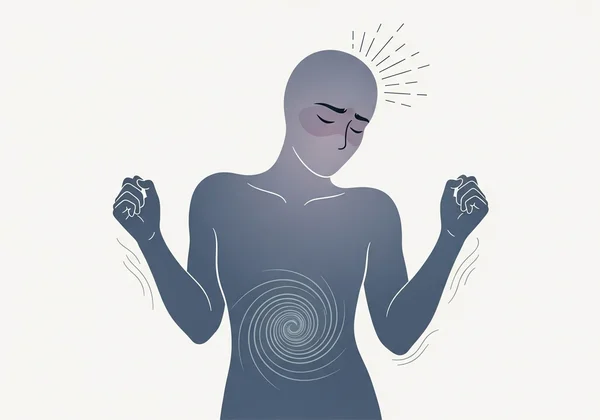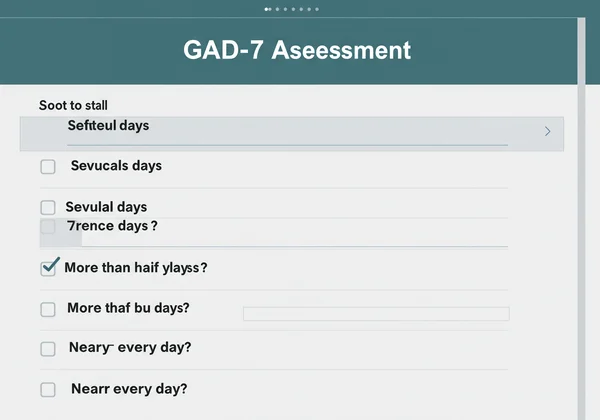Understanding GAD: Symptoms, Causes, & The GAD-7 Link
Feeling constantly worried or on edge? If that persistent hum of anxiety feels overwhelming, you are not alone. This guide is here to bring clarity to what Generalized Anxiety Disorder (GAD) is, how it differs from the stress we all experience, and to answer the crucial question: What is GAD7? Understanding your experiences is the first step toward managing them, and a powerful tool like the GAD-7 can help you gain clarity on your feelings in a safe and confidential way.
What is Generalized Anxiety Disorder (GAD)?
Generalized Anxiety Disorder, or GAD, is more than just worrying about an upcoming exam or a stressful day at work. GAD is a mental health condition marked by persistent, excessive worry about many different things—from health and money to family and work—that is difficult to control. This isn't just a fleeting feeling; it's a state of chronic apprehension that can last for months or even years, significantly impacting your well-being.
The core of GAD is a sense of dread or unease that doesn't seem to have a single, identifiable cause. It’s the "what if" that plays on a loop, making it hard to relax and enjoy the present moment. This constant state of high alert is mentally and physically exhausting.
GAD vs. Everyday Worries: Key Differences to Know
We all worry. It's a normal human response to uncertainty. However, the chronic worry associated with GAD is different in several key ways. While everyday worry is typically specific and temporary (e.g., "I'm worried about this job interview"), GAD-related worry is often pervasive, unfocused, and disproportionate to the actual situation.
Think of it this way: everyday worry is a puddle you can step over, while GAD is more like trying to walk through a persistent fog. It clouds your thoughts, interferes with your concentration, and affects your ability to function. The worry itself becomes a source of distress, creating a cycle that can feel impossible to break.

How Common is GAD? Understanding Its Prevalence
If you're struggling with these feelings, know that you are far from isolated. GAD is one of the most common mental health conditions worldwide, affecting millions of people from all walks of life. Recognizing its prevalence can be a comforting reminder that support is available and that many others have walked a similar path toward understanding and managing their anxiety.
Recognizing Generalized Anxiety Disorder Symptoms
The symptoms of GAD are not just in your head; they can manifest throughout your body. They are generally categorized into emotional, cognitive, and physical signs. Many people might not even realize that their physical ailments, like persistent headaches or digestive issues, are linked to their mental state. A key step is to understand your symptoms better.
Emotional and Cognitive Signs of GAD
The mental toll of GAD is significant and can disrupt your thinking patterns and emotional stability. Key signs include:
- Persistent, uncontrollable worry about numerous events or activities.
- Overthinking plans and solutions to all possible worst-case scenarios.
- Difficulty concentrating or feeling like your mind "goes blank."
- Feeling irritable, restless, or constantly on edge.
- A pervasive sense of dread or apprehension.
Physical Symptoms Associated with GAD
Anxiety is a full-body experience. The mind's constant state of alert sends signals that can wear down your physical health over time. Common physical symptoms include:

- Fatigue and chronic tiredness.
- Muscle tension, aches, and soreness.
- Trouble falling or staying asleep (insomnia).
- Stomachaches, nausea, or other digestive issues like irritable bowel syndrome (IBS).
- Headaches, trembling, or twitching.
How GAD Impacts Daily Life and Functioning
When these symptoms become chronic, they can seep into every corner of your life. GAD can make it difficult to perform at work or school, strain relationships with family and friends, and make simple daily tasks feel monumental. This impact on daily functioning is a crucial indicator that what you're experiencing is more than just typical stress.
Exploring the Potential Causes of GAD
There isn't a single switch that causes GAD. Instead, it’s understood to arise from a complex interplay of various risk factors. Understanding these potential causes can help demystify the condition and reduce self-blame. It's not a personal failing; it's a health condition with real, identifiable contributors.
Genetic and Biological Factors in GAD Development
Evidence suggests that GAD can run in families, indicating a genetic predisposition. If a close relative has an anxiety disorder, your risk may be higher. Biologically, it's believed that an imbalance in brain chemicals known as neurotransmitters, such as serotonin and norepinephrine, which help regulate mood and stress, can play a significant role.
Environmental & Life Experience Triggers for Anxiety
Your life experiences and environment are powerful shapers of your mental health. Prolonged exposure to stressful situations—such as a high-pressure job, financial instability, or relationship difficulties—can contribute to the development of GAD. Furthermore, past trauma or significant life changes, both positive and negative, can act as triggers for anxiety.

The GAD-7 and Understanding Your Anxiety Journey
This is where the GAD-7 assessment comes in as a helpful tool. This widely used questionnaire, which stands for Generalized Anxiety Disorder 7-item scale, is a simple yet powerful tool designed to screen for symptoms of GAD. It's a way to translate those vague feelings of worry and unease into a clear, measurable score that can provide valuable insight.
How the GAD-7 Screens for Generalized Anxiety
The GAD7 questionnaire consists of seven questions, each targeting a core symptom of GAD experienced over the last two weeks. These questions cover everything from feeling nervous and being unable to stop worrying to becoming easily annoyed or irritable. By rating the frequency of these experiences, the tool calculates a total score that corresponds to different levels of anxiety severity—mild, moderate, or severe. It provides a snapshot of your current mental state, empowering you to take the first step toward understanding.

Is the GAD-7 a Diagnosis for GAD? Clarity on Screening Tools
This is a critical point: this scale is a screening tool, not a diagnostic one. A high score on the GAD 7 test does not mean you have GAD, but it is a strong indicator that you may be experiencing significant anxiety symptoms and could benefit from speaking with a healthcare professional. Think of it as a smoke alarm; it alerts you to potential danger but doesn't tell you the cause of the fire. The gad 7 score interpretation is designed to be a starting point for a deeper conversation about your mental health.
Taking the First Step: Understanding GAD & Your Path Forward
Understanding that your feelings might be symptoms of a manageable condition like GAD is a monumental first step. It shifts the narrative from "What's wrong with me?" to "What can I do to feel better?" Knowledge is empowering, and recognizing the signs, causes, and impacts of anxiety puts you back in the driver's seat.
If this article resonates with you, the next step is simple, confidential, and free. Taking a few moments to complete a GAD-7 assessment can provide the objective feedback you need to move forward with confidence. You can get an instant score and even opt for a unique AI-powered report for deeper, personalized insights. Ready to learn more? Start your GAD7 assessment today.
Frequently Asked Questions About GAD & the GAD-7
What is the GAD-7 test?
The GAD-7 test is a widely used, scientifically validated self-assessment consisting of seven questions. It helps screen for the severity of anxiety symptoms by asking how often you have been bothered by issues like nervousness, excessive worry, and irritability over the past two weeks. It's a quick and reliable way to get a baseline understanding of your anxiety levels.
Is a GAD-7 score a formal diagnosis of Generalized Anxiety Disorder?
No, it is not. This is very important to remember. The assessment is a screening tool, not a diagnostic instrument. Only a qualified healthcare professional, like a doctor or psychologist, can provide a formal diagnosis after a comprehensive evaluation. The score is meant to be an informative guide to help you and your provider understand your symptoms.
What should I do if I think I have GAD?
If you suspect you may have GAD, a great first step is to gather information. Using a confidential online tool like the GAD-7 can provide a helpful starting point. The most important step, especially if your symptoms are causing distress, is to schedule an appointment with a healthcare professional to discuss your concerns and explore potential treatment options.
Can simple coping strategies help reduce anxiety symptoms?
Yes, for many people, lifestyle adjustments and coping strategies can make a significant difference. Practices like regular exercise, mindfulness meditation, a balanced diet, and ensuring adequate sleep can help manage mild anxiety symptoms. However, for moderate to severe anxiety, these strategies are often most effective when used alongside professional treatment like therapy or medication.